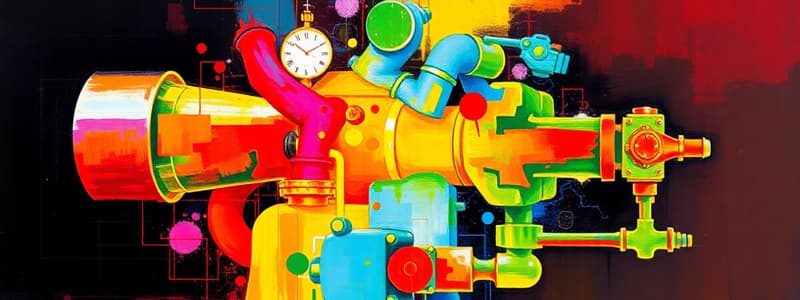Podcast
Questions and Answers
What is the primary purpose of compressing vapor ethylene?
What is the primary purpose of compressing vapor ethylene?
To achieve the high pressure required for feeding into reactors.
Which component cools the vapor ethylene after the first stage of compression?
Which component cools the vapor ethylene after the first stage of compression?
E-120A/B (Charge Gas Interstage Coolers).
What happens to vapor ethylene as it is compressed?
What happens to vapor ethylene as it is compressed?
It heats up due to the compression process.
What is the function of D-120A/B (Charge Gas Interstage K.O. Drums)?
What is the function of D-120A/B (Charge Gas Interstage K.O. Drums)?
Which tanks are involved in the suction and discharge process during the first stage of compression?
Which tanks are involved in the suction and discharge process during the first stage of compression?
How does cooling the vapor ethylene affect the operation of the compressors?
How does cooling the vapor ethylene affect the operation of the compressors?
Which stage of the compressors does the vapor ethylene enter after passing through D-120A/B?
Which stage of the compressors does the vapor ethylene enter after passing through D-120A/B?
What is the significance of maintaining a constant second stage temperature during compression?
What is the significance of maintaining a constant second stage temperature during compression?
Where is the vapor ethylene routed after exiting the second stage of compression?
Where is the vapor ethylene routed after exiting the second stage of compression?
What role do cooling water on the tube side of the coolers play?
What role do cooling water on the tube side of the coolers play?
How does the compression of vapor ethylene affect its temperature?
How does the compression of vapor ethylene affect its temperature?
What is routed to the shell side of E-120A/B during the compression process?
What is routed to the shell side of E-120A/B during the compression process?
What happens to trace heavier components in vapor ethylene after passing through D-120A/B?
What happens to trace heavier components in vapor ethylene after passing through D-120A/B?
What is the role of the Charge Gas Compressors C-120A/B in the process?
What is the role of the Charge Gas Compressors C-120A/B in the process?
Identify the two stages through which vapor ethylene passes in the compressors.
Identify the two stages through which vapor ethylene passes in the compressors.
Where does the vapor ethylene go after exiting the 1st stage of compression?
Where does the vapor ethylene go after exiting the 1st stage of compression?
What is the purpose of D-121A/B-3 and D-121A/B-4 in the compression process?
What is the purpose of D-121A/B-3 and D-121A/B-4 in the compression process?
What does the 'Charge Gas Interstage K.O. Drums' do during the compression process?
What does the 'Charge Gas Interstage K.O. Drums' do during the compression process?
Why is it important to reduce the heat of compression?
Why is it important to reduce the heat of compression?
Describe the flow of vapor ethylene during the second stage of compression.
Describe the flow of vapor ethylene during the second stage of compression.
Study Notes
Compression Process Overview
- Vapor ethylene is compressed to high pressure for reactor feeding.
- Initial routing occurs from the overhead of D-110 (Charge Gas Compressor Suction Drum) to the 1st Stage of C-120A/B (Charge Gas Compressors).
Stage 1 Compression
- Vapor ethylene enters D-121A/B-1 and D-121A/B-2 (1st Stage Suction Bottles) before reaching the 1st Stage compressors.
- Exits through D-121A/B-3 and D-121A/B-4 (1st Stage Discharge Bottles).
Heat Management
- Compression generates heat; the vapor ethylene is cooled to maintain a consistent 2nd stage temperature.
- Cooled via E-120A/B (Charge Gas Interstage Coolers) with cooling water on the tube side.
Efficiency Gains
- Heat removal reduces horsepower needs, enhancing compressor efficiency.
Separation of Components
- Cooled vapor ethylene moves to D-120A/B (Charge Gas Interstage K.O. Drums) where heavier components are separated.
- Trace components are routed to T-340 (Caustic Wash Vapor Scrubber) from D-120A/B’s bottom.
Stage 2 Compression
- Vapor ethylene from the overhead of D-120A/B is routed to the 2nd Stage of C-120A/B.
- Water vapor enters D-121A/B-5 and D-121A/B-6 (2nd Stage Suction Bottles) before the 2nd Stage compressors.
Final Compression Stage
- Vapor ethylene exits the 2nd Stage through D-121A/B-7 and D-121A/B-8, achieving adequate pressure for feed to reactors R-201-205.
Compression Process Overview
- Vapor ethylene is compressed to high pressure for reactor feeding.
- Initial routing occurs from the overhead of D-110 (Charge Gas Compressor Suction Drum) to the 1st Stage of C-120A/B (Charge Gas Compressors).
Stage 1 Compression
- Vapor ethylene enters D-121A/B-1 and D-121A/B-2 (1st Stage Suction Bottles) before reaching the 1st Stage compressors.
- Exits through D-121A/B-3 and D-121A/B-4 (1st Stage Discharge Bottles).
Heat Management
- Compression generates heat; the vapor ethylene is cooled to maintain a consistent 2nd stage temperature.
- Cooled via E-120A/B (Charge Gas Interstage Coolers) with cooling water on the tube side.
Efficiency Gains
- Heat removal reduces horsepower needs, enhancing compressor efficiency.
Separation of Components
- Cooled vapor ethylene moves to D-120A/B (Charge Gas Interstage K.O. Drums) where heavier components are separated.
- Trace components are routed to T-340 (Caustic Wash Vapor Scrubber) from D-120A/B’s bottom.
Stage 2 Compression
- Vapor ethylene from the overhead of D-120A/B is routed to the 2nd Stage of C-120A/B.
- Water vapor enters D-121A/B-5 and D-121A/B-6 (2nd Stage Suction Bottles) before the 2nd Stage compressors.
Final Compression Stage
- Vapor ethylene exits the 2nd Stage through D-121A/B-7 and D-121A/B-8, achieving adequate pressure for feed to reactors R-201-205.
Studying That Suits You
Use AI to generate personalized quizzes and flashcards to suit your learning preferences.
Description
This quiz focuses on the compression section of vapor ethylene, detailing its route from the Charge Gas Compressor Suction Drum to the 1st Stage of the Charge Gas Compressors. Test your knowledge on the equipment and processes involved in this crucial phase of ethylene processing.




